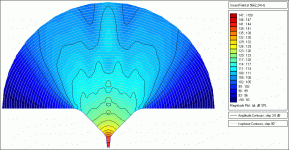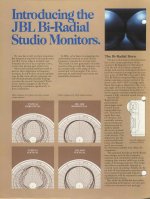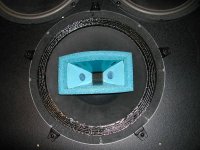One huge problem that NO loudspeaker can address is the limitations created by the 2-channel stereo format itself. It simply defies nature to present any individual sound source by using multiple sources (loudspeakers) located elsewhere.
As long as we are using traditional stereo, convincing realism for more than fleeting moments on selected recordings from a single listening position is the best that can be hoped for.
…
Indeed.
On top of that, see my above remark about reproducing even single instrument.
How many have multi-amped fully horn loaded 20 to 20K mains with matching rear and ceiling ambience channels 2 channel decoding by Circle Surround hybrid ultra wide (rear) and omni (ceiling) horn loaded with an extra rear dual 18 sub delayed to create a larger room psycho acoustically? Sure the recording needs to be good and it doesn't always sound real but it will scare (as in holy **** that's crazy, is it there?) anybody that sits down for a listen. I'm not "bragging" or saying it's the "best" I'm saying playback definitely can sound real. This is with 2 channel sources. We had 4 musicians in the house and are down to one (I'm not one of them) so real to me is real. Two channel alone can do this with a small percentage of recordings and horns seem to be the best at it. (my mains actually use ten horn loaded 15's and a single 18 sub hornn now, it will move the air without much compromise, don't expect real with your 15" direct radiator)
Last edited:
I think you are obsessed with "getting fooled". I could fool an expert into thinking a real instrument is not real. But getting a 50% chance of fooling an average music lover is good.
Hmm, does it count if I have a live person playing under covers and also have speakers under covers to let the listener guess which side is real?
Hmm, does it count if I have a live person playing under covers and also have speakers under covers to let the listener guess which side is real?
Last edited:
Getting fooled is the only way it will sound real obviously because it's not and it's a recording and yes I could say tricked or some other adjective. Being fooled was not the goal of my playback but is a final byproduct. LOL, a fool i am. Tone is where I've been at for decades and without that you can't fool me, but without the 3D size and the full body resonance tone is more for pleasant and satisfying sound then sounding realistic and alive. We all have our own perspectives.
SMART Audiophile and Home Theatre Products
SMART Audiophile and Home Theatre Products
I think you are obsessed with "getting fooled". I could fool an expert into thinking a real instrument is not real. But getting a 50% chance of fooling an average music lover is good.
Hmm, does it count if I have a live person playing under covers and also have speakers under covers to let the listener guess which side is real?
I don't get you point.
Are you saying that you have, or heard, a reproduction system that sounds like live music?
...
Tone is where I've been at for decades and without that you can't fool me, …
Are you saying that your system reproduces the tone of acoustic instruments in a way that it sounds like real instruments?
(By 'sounds like' I mean indistinguishable from real, live instruments).
… but without the 3D size and the full body resonance tone is more for pleasant and satisfying sound then sounding realistic and alive. We all have our own perspectives.
…
We agree on this.
However, to my experience, it isn't only the 3D reproduction that reproduction systems fall behind 'the real thing'.
Maybe, maybe not. But there are systems (I've heard them) that can make a very convincing illusion of the real thing - be that a solo cello, a jazz club or a full symphony with choir.One huge problem that NO loudspeaker can address is the limitations created by the 2-channel stereo format itself.
The major limitation being size. Size matters. It's very hard to do in a small room with small speakers. Maybe impossible. But given the right room and the right speakers, it can be done. I've heard it done more than once. Unfortunately.

Maybe, maybe not. But there are systems (I've heard them) that can make a very convincing illusion of the real thing - be that a solo cello, a jazz club or a full symphony with choir.
The major limitation being size. Size matters. It's very hard to do in a small room with small speakers. Maybe impossible. But given the right room and the right speakers, it can be done. I've heard it done more than once. Unfortunately.
Hi Pano,
I'm not sure what do you mean by "a very convincing illusion of the real thing".
Do you mean that an experienced listener, entering the room blindfolded, will think one is attending live concert?
I don't know - didn't try that trick. 
I mean that of the several 1000s that attended the demos, most were amazed at how much it sounded "like the real thing". Many were surprised and perplexed that speakers could do that. And across many recordings and genres.
I also remember walking into a demo room in Vegas at The Show and hearing a symphonic recording that was very, very lifelike. It strikes you right away, how lifelike it is. Is it perfect? No. But is it close enough that you don't care? Yes.
There are some systems and rooms up in Seattle that also have that reputation, tho I haven't heard them personally.
I mean that of the several 1000s that attended the demos, most were amazed at how much it sounded "like the real thing". Many were surprised and perplexed that speakers could do that. And across many recordings and genres.
I also remember walking into a demo room in Vegas at The Show and hearing a symphonic recording that was very, very lifelike. It strikes you right away, how lifelike it is. Is it perfect? No. But is it close enough that you don't care? Yes.
There are some systems and rooms up in Seattle that also have that reputation, tho I haven't heard them personally.
What would benefit us listeners is if the recording industry actually standardized the entire recording chain from the mics, levels and placement to the final data transfer and CD production. That way it would be easier to get the most out of our recordings. Another pipe dream "dolby labs". THX, blah blah.. maybe take some lessons from Pierre Sprey & Co
Best,
Pooh Mussolini
Best,
Pooh Mussolini
I don't know - didn't try that trick.
I mean that of the several 1000s that attended the demos, most were amazed at how much it sounded "like the real thing". Many were surprised and perplexed that speakers could do that. And across many recordings and genres.
I also remember walking into a demo room in Vegas at The Show and hearing a symphonic recording that was very, very lifelike. It strikes you right away, how lifelike it is. Is it perfect? No. But is it close enough that you don't care? Yes.
There are some systems and rooms up in Seattle that also have that reputation, tho I haven't heard them personally.
Thank you.
I got your meaning.
Yet, what you said doesn't contradict what I said.
What would benefit us listeners is if the recording industry actually standardized the entire recording chain from the mics, levels and placement...
Interesting. One gotcha is that different mics sound completely different from each other. Some are bright and crisp (e.g., AKG 414), others are beautifully full (e.g., Neumann U87 or other large diaphram condensers). Same with levelers, compressers, reverb units, the EQ on different consoles (e.g. vintage Neve), mic pre's etc.
Not likely to ever happen. It would get in the way of making it "sound cool" and of earning money. And most people would hate the standard anyway.
Indeed.
Lynn,Comparison of AH425 and CD waveguide at 1 kHz.
Since you did not answer the question I posed:
"What is the -6 dB beamwidth of the horn you are using in the "Beyond the Ariel" prototype at 500, 2000, 4000, 10,000 Hz?"
And then posted simulations, rather than measurements, am I correct in assuming you have not measured the actual polar response of the horn (or woofer) you are using in the "Beyond the Ariel" prototype?
Art
Robh3606,
I think what you are pointing out here about the polar response of the cd horn is something that most just don't seem to realize or disregard in whole. There are not any real constant directivity horn lenses that do not have lobs like you are seeing. What we see often are these smoothed polar plots that are hiding the real situation with nice pretty colors. I have never seen any horn or waveguide that does not have some beaming at higher frequencies and this causes lobing in the response curves when you really look for the details. Lower frequencies will also have a type of lobing that will be outside of the angular pattern that is described by the wall angle of the horn. I don't think this has anything to do with whether the horn is round or elliptical or even square. A round conic horn may have the smoothest polar responses but will also have some of this lobing at both extremes of the output.
ps. This is one of the reasons that I actually prefer the old single frequency polar graphs, you can see what is happening at individual frequencies and these details are not lost in the singular polar plots as we are seeing in these last few posts. Yes it is more difficult to see overall what is happening but the resolution of the details is not lost. There is nothing wrong with seeing an overall detailed map as just shown, but it does not tell the entire story.
I think what you are pointing out here about the polar response of the cd horn is something that most just don't seem to realize or disregard in whole. There are not any real constant directivity horn lenses that do not have lobs like you are seeing. What we see often are these smoothed polar plots that are hiding the real situation with nice pretty colors. I have never seen any horn or waveguide that does not have some beaming at higher frequencies and this causes lobing in the response curves when you really look for the details. Lower frequencies will also have a type of lobing that will be outside of the angular pattern that is described by the wall angle of the horn. I don't think this has anything to do with whether the horn is round or elliptical or even square. A round conic horn may have the smoothest polar responses but will also have some of this lobing at both extremes of the output.
ps. This is one of the reasons that I actually prefer the old single frequency polar graphs, you can see what is happening at individual frequencies and these details are not lost in the singular polar plots as we are seeing in these last few posts. Yes it is more difficult to see overall what is happening but the resolution of the details is not lost. There is nothing wrong with seeing an overall detailed map as just shown, but it does not tell the entire story.
Last edited:
Hello Kindhornman
I am aware that there may be lobing but not to that extreme. Here's the polar plot of a JBL 4430. That was in 80's. Things are better not worse. That comparison is with a URIE 811. You can very clearly see the lobing in the vertical of the 811 which had a small asymmetrical rectangular coaxial mounted exponential horn.
I happen to be a fan of both horns in these systems just with the UREI you were chained to the horn so to speak. You needed to have your ears right on the horns axis. At least with the 2344 you had a large sweet spot to move around in.
Rob
I am aware that there may be lobing but not to that extreme. Here's the polar plot of a JBL 4430. That was in 80's. Things are better not worse. That comparison is with a URIE 811. You can very clearly see the lobing in the vertical of the 811 which had a small asymmetrical rectangular coaxial mounted exponential horn.
I happen to be a fan of both horns in these systems just with the UREI you were chained to the horn so to speak. You needed to have your ears right on the horns axis. At least with the 2344 you had a large sweet spot to move around in.
Rob
Attachments
Robh3606,
I know the UREI speakers well and they are just a modified Altec coaxial as far as I am concerned. At some point those horns had soft foam placed around that little horn to smooth out some of the diffraction from the sharp edges of the horn lens. The JBL speaker is a very different animal. it is not a coaxial design and you could do much more with that much larger Bi-radial horn, but at the same time you also now had a loss of the coherency of the single point source coaxial. I also must say that I do not believe those JBL polar plots in the least. I know they use smoothing and every other trick in the book to make their products look better than they truly are. Those polars of that bi-radial are more than suspect in my eyes.
I know the UREI speakers well and they are just a modified Altec coaxial as far as I am concerned. At some point those horns had soft foam placed around that little horn to smooth out some of the diffraction from the sharp edges of the horn lens. The JBL speaker is a very different animal. it is not a coaxial design and you could do much more with that much larger Bi-radial horn, but at the same time you also now had a loss of the coherency of the single point source coaxial. I also must say that I do not believe those JBL polar plots in the least. I know they use smoothing and every other trick in the book to make their products look better than they truly are. Those polars of that bi-radial are more than suspect in my eyes.
I know they use smoothing and every other trick in the book to make their products look better than they truly are. Those polars of that bi-radial are more than suspect in my eyes.
Hello kindhornman
You mean like everyone else? You don't find that SIM odd especially when you compare it to the other horn?? Why so much SPL loss from the throat compared to the other horn??
At some point those horns had soft foam placed around that little horn to smooth out some of the diffraction from the sharp edges of the horn lens.
Inside it as well.
Rob
Attachments
- Home
- Loudspeakers
- Multi-Way
- Beyond the Ariel


